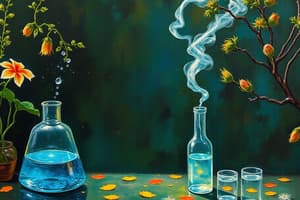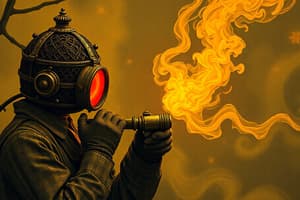Podcast
Questions and Answers
What was the primary effect of chlorine gas on soldiers?
What was the primary effect of chlorine gas on soldiers?
- Vomiting and internal bleeding
- Blindness and fungal infections
- Blistering of the skin
- Coughing and struggling to breathe (correct)
What was the smell of mustard gas similar to?
What was the smell of mustard gas similar to?
- Onions and lemons
- Pine and eucalyptus
- Garlic and horseradish (correct)
- Roses and lavender
How did soldiers protect themselves from chlorine gas?
How did soldiers protect themselves from chlorine gas?
- By wearing masks made of cotton soaked in water
- By wearing masks made of cotton soaked in urine (correct)
- By wearing masks made of metal wire mesh
- By digging deeper trenches
What was the main cause of trench foot?
What was the main cause of trench foot?
How many British soldiers died from mustard gas attacks?
How many British soldiers died from mustard gas attacks?
What happened to the bodies of soldiers in the trenches due to the presence of rats?
What happened to the bodies of soldiers in the trenches due to the presence of rats?
Why did soldiers cheer when the Germans used mustard gas on the British?
Why did soldiers cheer when the Germans used mustard gas on the British?
How did soldiers use rats to their advantage in the trenches?
How did soldiers use rats to their advantage in the trenches?
Why were lice difficult to get rid of in the trenches?
Why were lice difficult to get rid of in the trenches?
What was a side effect of having lice in the trenches?
What was a side effect of having lice in the trenches?
Flashcards are hidden until you start studying
Study Notes
Gas Attacks
- Chlorine gas was a common gas used during WWI, causing victims to experience chest pains and a burning sensation in their throat.
- It was used as a choking agent, making soldiers cough and struggle to breathe.
- To protect themselves, the Allies made masks out of cotton soaked in urine to prevent the deadly chlorine from entering their bodies.
- Mustard gas was a yellow-brown color, smelled like garlic and horseradish, and caused skin blisters, eye soreness, and vomiting.
- Mustard gas led to internal and external bleeding and was extremely painful, often taking 4-5 weeks to kill victims.
- Most victims had to be strapped to their beds during this process and were unable to return to the front, requiring extensive care.
- British Gas Casualties: 1914-18 - Chlorine: 1,976 deaths, 164,457 non-fatal. Mustard Gas: 4,086 deaths, 16,526 non-fatal.
Trench Foot
- Trench foot is a fungal infection of the feet caused by cold, wet, and unsanitary trench conditions.
- Soldiers were forced to stand in ankle-deep water for hours without being able to dry their shoes or socks, making it impossible to avoid getting trench foot.
- If the infection became too serious, soldiers would have to have their foot amputated.
- Poor hygiene in the trenches led to the spread of disease, with overflowing latrines, rotting corpses, and dirty conditions.
Rats
- There were no beds in the trenches, and soldiers had to sleep on the floor with millions of rats infesting the trenches.
- Rats would spread infection, contaminate food, and even eat human remains, including eyes and liver.
- Brown rats were especially feared, growing to the size of a cat and becoming unafraid of humans.
- Rats would bite chunks out of soldiers at night, but they did have some use in the trenches, providing warning of attacks and serving as a food source when rations were short.
Lice
- Lice were a constant problem in the trenches, infesting soldiers' clothes and bodies, making them itchy and uncomfortable.
- They were difficult to get rid of due to the lack of washing facilities in the trenches.
- Lice laid eggs in the seams of soldiers' uniforms, which could not be removed by delousing power.
- Shaving their heads was a way for soldiers to try and avoid getting nits.
- Lice passed on infections, especially when soldiers had cuts and wounds, with the most severe infection being known as...
Studying That Suits You
Use AI to generate personalized quizzes and flashcards to suit your learning preferences.




